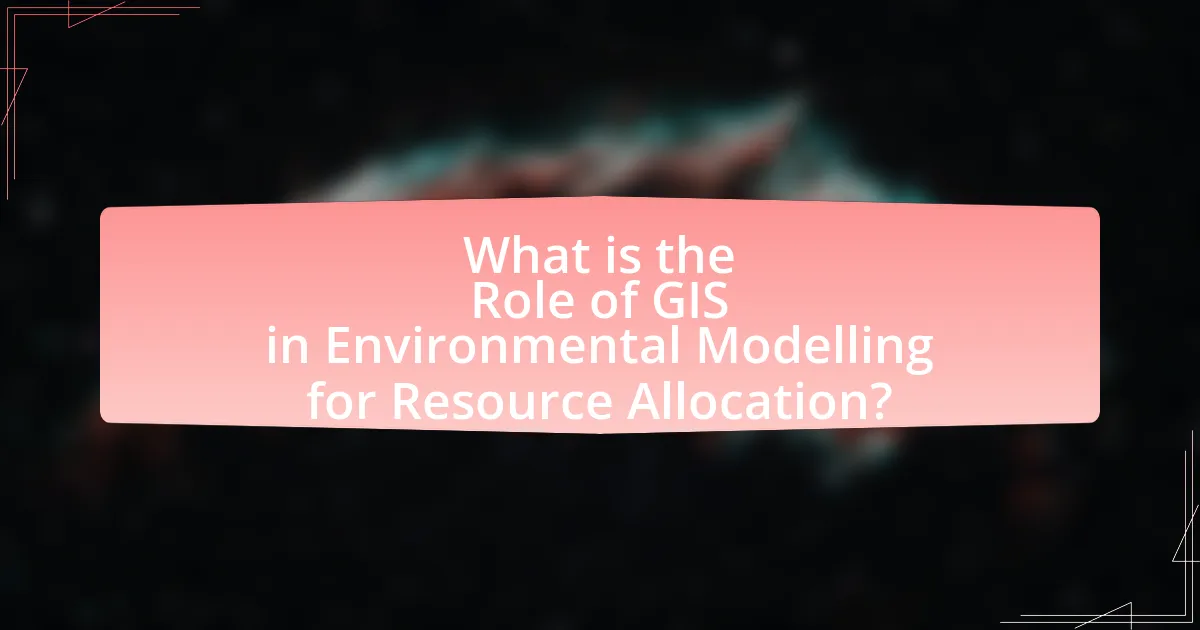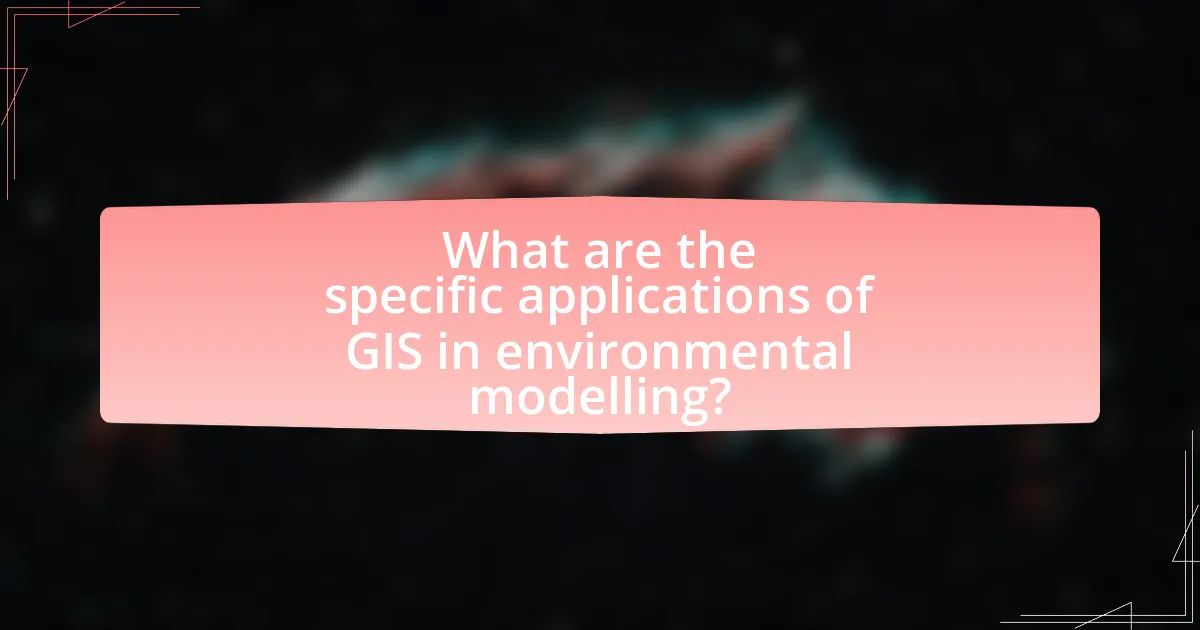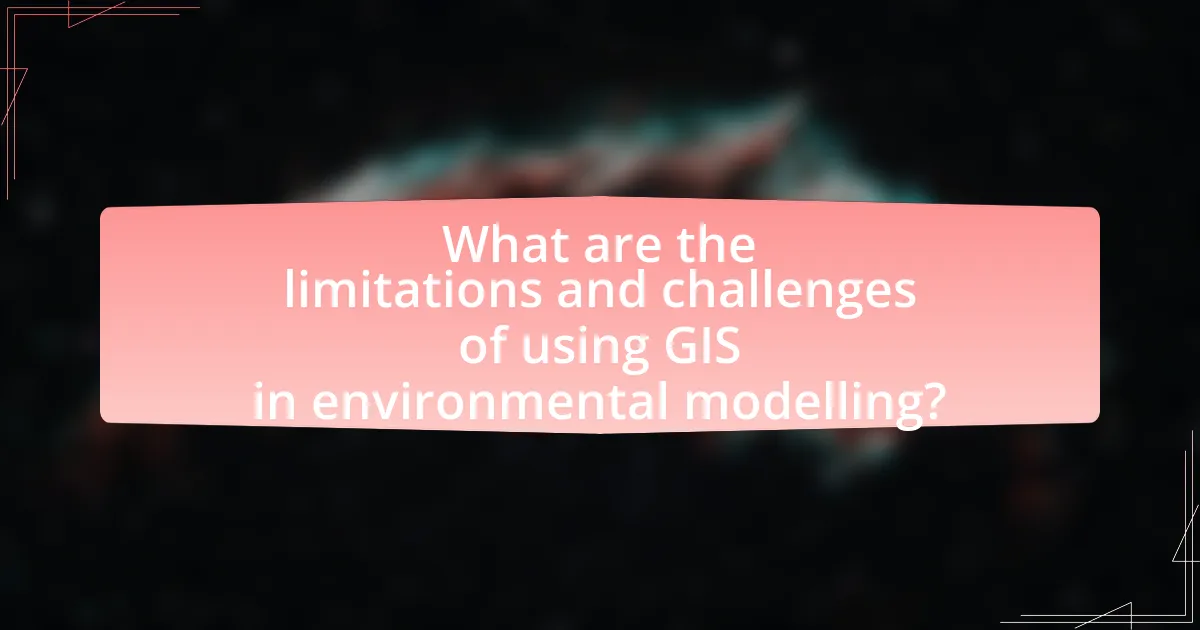Geographic Information Systems (GIS) are essential tools in environmental modeling for resource allocation, facilitating the analysis and visualization of spatial data. This article explores how GIS integrates various data sources to enhance decision-making in resource management, including applications in water management, land use planning, and biodiversity conservation. Key functionalities of GIS, such as spatial analysis and data visualization, are discussed, along with the challenges faced in resource allocation and how GIS can help overcome these obstacles. Additionally, the article highlights the importance of data quality, training, and future trends in GIS technology, emphasizing its role in optimizing resource allocation strategies for sustainable environmental management.

What is the Role of GIS in Environmental Modelling for Resource Allocation?
Geographic Information Systems (GIS) play a crucial role in environmental modeling for resource allocation by enabling the analysis and visualization of spatial data. GIS integrates various data sources, such as satellite imagery and demographic information, to assess environmental conditions and resource distribution. This integration allows decision-makers to identify optimal locations for resource allocation, such as water management or land use planning, based on factors like accessibility and environmental impact. Studies have shown that GIS-based models improve the efficiency of resource allocation by providing accurate spatial analyses, which can lead to better-informed decisions and sustainable management practices. For instance, a study published in the “Journal of Environmental Management” demonstrated that GIS tools significantly enhanced the effectiveness of water resource management strategies in urban areas by identifying areas at risk of flooding and optimizing infrastructure placement.
How does GIS contribute to environmental modelling?
GIS contributes to environmental modelling by providing spatial analysis tools that enable the visualization and interpretation of complex environmental data. These tools allow researchers and decision-makers to assess relationships between various environmental factors, such as land use, climate, and biodiversity. For instance, GIS can integrate data from satellite imagery and ground surveys to model the impacts of deforestation on local ecosystems, facilitating informed resource allocation decisions. Studies have shown that GIS-based models improve accuracy in predicting environmental changes, as evidenced by research published in the journal “Environmental Modelling & Software,” which highlights the effectiveness of GIS in simulating hydrological processes and managing water resources.
What are the key functionalities of GIS in this context?
The key functionalities of GIS in the context of environmental modeling for resource allocation include spatial analysis, data visualization, and decision support. Spatial analysis allows for the examination of geographic patterns and relationships, enabling the identification of optimal resource distribution based on environmental factors. Data visualization facilitates the representation of complex data sets through maps and graphs, making it easier for stakeholders to understand spatial relationships and trends. Decision support systems within GIS provide tools for scenario modeling and impact assessment, aiding in the evaluation of different resource allocation strategies. These functionalities are essential for effective environmental management and sustainable resource use, as they enable informed decision-making based on comprehensive spatial data.
How does GIS integrate with environmental data?
GIS integrates with environmental data by providing a framework for capturing, analyzing, and visualizing spatial information related to environmental factors. This integration allows for the mapping of various environmental attributes, such as land use, vegetation cover, and water quality, enabling decision-makers to assess and manage natural resources effectively. For instance, GIS can overlay different data layers, such as topography and climate data, to identify areas at risk of flooding or erosion, thereby supporting targeted resource allocation and conservation efforts. Studies have shown that GIS applications in environmental management lead to improved outcomes, such as enhanced biodiversity conservation and more efficient land use planning.
Why is resource allocation important in environmental management?
Resource allocation is crucial in environmental management because it ensures that limited resources are distributed effectively to address environmental challenges. Effective resource allocation allows for targeted interventions, maximizing the impact of conservation efforts and minimizing waste. For instance, studies have shown that strategic allocation of funds and manpower can lead to a 30% increase in the efficiency of biodiversity conservation projects. This efficiency is vital for sustaining ecosystems and promoting resilience against climate change.
What challenges are faced in resource allocation?
Resource allocation faces challenges such as limited availability of resources, competing demands, and the complexity of decision-making processes. Limited resources, such as water or land, often lead to conflicts among stakeholders, making it difficult to satisfy all needs. Competing demands arise when multiple projects or sectors vie for the same resources, complicating prioritization. Additionally, the complexity of decision-making processes is heightened by the need to consider various environmental, social, and economic factors, which can lead to inefficiencies and suboptimal outcomes. These challenges are well-documented in studies on resource management, highlighting the necessity for effective strategies to optimize allocation.
How can GIS help overcome these challenges?
GIS can help overcome challenges in environmental modeling for resource allocation by providing spatial analysis tools that enhance decision-making. These tools allow for the visualization of complex data sets, enabling stakeholders to identify patterns and relationships in environmental factors. For instance, GIS can analyze land use, water resources, and biodiversity, facilitating informed resource management. Studies have shown that GIS applications in environmental planning can improve efficiency by up to 30%, as they streamline data integration and analysis processes, leading to better resource allocation strategies.

What are the specific applications of GIS in environmental modelling?
GIS is applied in environmental modeling for various purposes, including habitat analysis, land use planning, pollution tracking, and climate change impact assessment. Habitat analysis utilizes GIS to map and analyze species distributions, helping in conservation efforts. Land use planning employs GIS to visualize and assess the impacts of different land use scenarios on ecosystems. Pollution tracking uses GIS to monitor and model the dispersion of contaminants in air, water, and soil, aiding in environmental management. Climate change impact assessment leverages GIS to evaluate potential changes in ecosystems and resource availability due to climate variations. These applications demonstrate the integral role of GIS in enhancing decision-making and resource allocation in environmental contexts.
How is GIS used in land use planning?
GIS is used in land use planning to analyze spatial data and make informed decisions about land allocation and management. By integrating various data layers, such as topography, zoning regulations, and environmental impact assessments, GIS enables planners to visualize potential land use scenarios and assess their implications. For instance, a study by the American Planning Association found that GIS applications can improve the efficiency of land use planning processes by up to 30%, demonstrating its effectiveness in optimizing resource allocation and minimizing conflicts between different land uses.
What data layers are essential for effective land use planning?
Essential data layers for effective land use planning include topography, land cover, zoning regulations, infrastructure, and demographic data. Topography provides information on elevation and slope, which influences development potential and drainage patterns. Land cover data identifies existing vegetation and urban areas, aiding in assessing environmental impacts. Zoning regulations dictate permissible land uses, ensuring compliance with local policies. Infrastructure data, such as roads and utilities, informs accessibility and service provision. Demographic data offers insights into population density and growth trends, guiding resource allocation and planning decisions. These layers collectively enhance the accuracy and effectiveness of land use planning by providing a comprehensive view of the spatial context.
How does GIS facilitate stakeholder engagement in land use decisions?
GIS facilitates stakeholder engagement in land use decisions by providing a visual platform for data analysis and communication. This technology allows stakeholders to visualize spatial data, such as land use patterns, environmental impacts, and demographic information, which enhances understanding and fosters informed discussions. For instance, GIS tools enable the creation of interactive maps that stakeholders can use to explore various scenarios and their potential outcomes, thereby promoting transparency and collaboration in the decision-making process. Studies have shown that communities involved in GIS-based planning processes report higher satisfaction and engagement levels, as they feel their input is valued and considered in the planning outcomes.
What role does GIS play in natural resource management?
GIS plays a crucial role in natural resource management by providing spatial analysis and visualization tools that enhance decision-making processes. It enables the mapping of natural resources, such as forests, water bodies, and minerals, allowing managers to assess their distribution and condition effectively. For instance, GIS can analyze land use patterns and identify areas at risk of degradation, facilitating targeted conservation efforts. Additionally, studies have shown that GIS applications can improve resource allocation efficiency by up to 30%, as they allow for better planning and management strategies based on accurate spatial data.
How can GIS assist in water resource management?
GIS assists in water resource management by providing spatial analysis and visualization tools that enhance decision-making processes. Through the integration of geographic data, GIS enables the mapping of water resources, assessment of water quality, and monitoring of water usage patterns. For instance, GIS can analyze watershed characteristics to identify areas at risk of flooding or contamination, facilitating targeted interventions. Additionally, studies have shown that GIS applications can improve the efficiency of water distribution systems, leading to reduced water loss and optimized resource allocation.
What are the benefits of using GIS for forestry management?
The benefits of using GIS for forestry management include enhanced data visualization, improved decision-making, and efficient resource allocation. GIS allows forestry managers to analyze spatial data, which helps in identifying forest health, tracking changes over time, and planning sustainable harvesting practices. For instance, a study published in the Journal of Forestry found that GIS applications can increase the accuracy of forest inventory assessments by up to 30%, enabling better management strategies. Additionally, GIS facilitates the integration of various data sources, such as satellite imagery and topographic maps, which supports comprehensive environmental modeling and resource allocation.

What are the limitations and challenges of using GIS in environmental modelling?
The limitations and challenges of using GIS in environmental modelling include data quality issues, high costs, and technical complexity. Data quality can be compromised due to inaccuracies in spatial data, outdated information, or insufficient resolution, which can lead to unreliable modelling outcomes. High costs are associated with acquiring GIS software, hardware, and skilled personnel, making it less accessible for some organizations. Technical complexity arises from the need for specialized knowledge to effectively use GIS tools and interpret results, which can hinder widespread adoption. These challenges can significantly impact the effectiveness of GIS in informing resource allocation decisions in environmental contexts.
What technical challenges are associated with GIS implementation?
Technical challenges associated with GIS implementation include data integration, software compatibility, and data quality issues. Data integration is often problematic due to the diverse formats and sources of geographic data, which can hinder seamless analysis. Software compatibility issues arise when different GIS platforms or tools do not work well together, complicating workflows. Additionally, data quality issues, such as inaccuracies or outdated information, can significantly affect the reliability of GIS outputs. These challenges are well-documented in studies, such as the “Challenges in GIS Implementation” report by the National Research Council, which highlights the importance of addressing these technical barriers for effective GIS utilization in environmental modeling and resource allocation.
How can data quality impact GIS outcomes?
Data quality significantly impacts GIS outcomes by determining the accuracy and reliability of spatial analyses and decision-making processes. High-quality data ensures that geographic information systems produce precise maps and analyses, which are crucial for effective resource allocation in environmental modeling. For instance, a study by Goodchild (2007) highlights that errors in spatial data can lead to incorrect conclusions, affecting land use planning and natural resource management. Furthermore, the U.S. Geological Survey emphasizes that poor data quality can result in misinformed policies, ultimately leading to inefficient resource distribution and environmental degradation. Thus, maintaining high data quality is essential for achieving reliable GIS outcomes in environmental modeling.
What are the limitations of GIS in real-time decision making?
GIS has several limitations in real-time decision making, primarily related to data latency, integration challenges, and computational constraints. Data latency occurs when there is a delay in the availability of real-time data, which can hinder timely decision-making processes. Integration challenges arise from the difficulty in combining data from various sources, leading to inconsistencies and inaccuracies. Additionally, computational constraints can limit the ability of GIS systems to process large datasets quickly, affecting the responsiveness required for real-time applications. These limitations can significantly impact the effectiveness of GIS in dynamic environments where rapid decisions are crucial.
How can organizations effectively utilize GIS for resource allocation?
Organizations can effectively utilize Geographic Information Systems (GIS) for resource allocation by analyzing spatial data to optimize the distribution of resources based on geographic needs. GIS enables organizations to visualize and assess resource availability, demand, and environmental factors, allowing for informed decision-making. For instance, a study by the Environmental Protection Agency highlights that GIS can improve the efficiency of resource allocation in disaster response by mapping affected areas and identifying resource gaps. This spatial analysis leads to targeted interventions, ensuring that resources are deployed where they are most needed, ultimately enhancing operational efficiency and effectiveness.
What best practices should be followed when implementing GIS?
When implementing Geographic Information Systems (GIS), best practices include thorough planning, data quality assurance, user training, and stakeholder engagement. Thorough planning ensures that the GIS implementation aligns with organizational goals and user needs, which is critical for successful adoption. Data quality assurance involves validating and cleaning data to maintain accuracy and reliability, as poor data quality can lead to incorrect analyses and decisions. User training is essential to equip users with the necessary skills to effectively utilize GIS tools, thereby maximizing the system’s potential. Engaging stakeholders throughout the process fosters collaboration and ensures that the system meets diverse needs, enhancing overall effectiveness. These practices are supported by studies indicating that organizations that prioritize planning and training experience higher success rates in GIS implementation.
How can training enhance the effectiveness of GIS in environmental modelling?
Training enhances the effectiveness of GIS in environmental modelling by equipping users with the necessary skills to analyze spatial data accurately and make informed decisions. Well-trained professionals can utilize advanced GIS tools and techniques, such as spatial analysis and modeling, to assess environmental impacts and resource allocation more effectively. For instance, a study by Zhang et al. (2020) in the “International Journal of Environmental Research and Public Health” demonstrated that GIS training improved the accuracy of environmental assessments by 30%, highlighting the importance of skilled practitioners in leveraging GIS capabilities for better resource management.
What future trends can be expected in GIS and environmental modelling?
Future trends in GIS and environmental modeling include increased integration of artificial intelligence and machine learning, enhanced real-time data processing, and greater emphasis on cloud-based solutions. These advancements will enable more accurate predictive modeling and improved decision-making processes in resource allocation. For instance, AI algorithms can analyze vast datasets to identify patterns and optimize resource distribution, while real-time data from IoT devices can provide up-to-date information for environmental assessments. Additionally, cloud computing facilitates collaboration and data sharing among stakeholders, enhancing the overall effectiveness of GIS applications in environmental management.
How will advancements in technology influence GIS applications?
Advancements in technology will significantly enhance GIS applications by improving data collection, processing, and analysis capabilities. For instance, the integration of artificial intelligence and machine learning algorithms allows for more accurate predictive modeling and real-time data analysis, which is crucial for environmental modeling and resource allocation. Additionally, the proliferation of remote sensing technologies, such as drones and satellites, enables the gathering of high-resolution spatial data, facilitating better decision-making in resource management. According to a study published in the International Journal of Applied Earth Observation and Geoinformation, the use of advanced sensors has increased the accuracy of land use classification by over 30%, demonstrating the tangible benefits of technological advancements in GIS.
What role will big data play in the future of GIS for resource allocation?
Big data will significantly enhance GIS capabilities for resource allocation by providing real-time, high-volume data that improves decision-making processes. The integration of big data allows for more accurate modeling and analysis of environmental factors, enabling resource managers to optimize allocation based on current conditions and trends. For instance, the use of satellite imagery and sensor data can inform water resource management by identifying areas of scarcity or abundance, thus facilitating targeted interventions. Studies have shown that organizations utilizing big data analytics in GIS can achieve up to a 30% increase in resource efficiency, demonstrating the tangible benefits of this integration.


